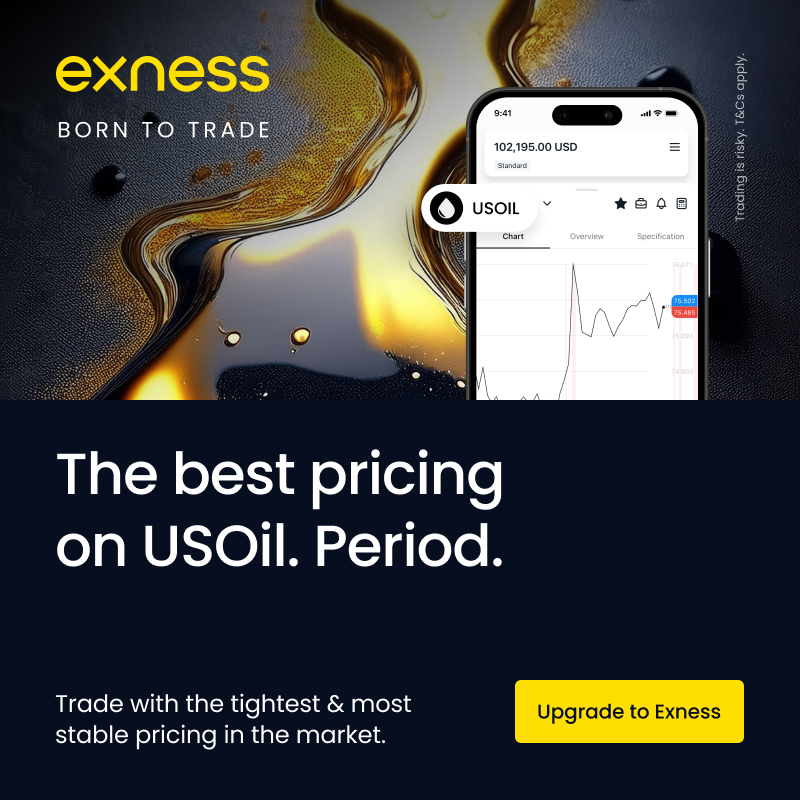
9 minute read
What is the spread on Exness Standard Account for Gold?
from Exness
by Exness_Blog
Gold trading has surged in popularity among retail and institutional traders due to its role as a safe-haven asset and hedge against inflation. When trading gold (XAU/USD) on platforms like Exness, one of the critical factors influencing profitability is the spread—the difference between the bid and ask price. For traders using the Exness Standard Account, understanding the spread on gold is essential to optimize trading strategies and manage costs effectively. In this article, we’ll dive deep into the spread on the Exness Standard Account for gold, compare it with industry standards, and explore how it impacts different trading styles in 2025.

💥 Trade with Exness now: Open An Account or Visit Brokers 🏆
Understanding Spreads in Gold Trading
Before delving into the specifics of the Exness Standard Account, let’s clarify what a spread is and why it matters. In forex and CFD trading, the spread represents the difference between the buying (ask) price and the selling (bid) price of an asset. For gold, which is typically traded as XAU/USD, the spread is often expressed in pips or cents per ounce.
For example, if the bid price for gold is $2,000.00 and the ask price is $2,000.20, the spread is 20 cents per ounce, equivalent to 2 pips (since 1 pip for XAU/USD equals 0.1 cents). The spread is a key trading cost, as traders must overcome it to achieve a profit. Tight spreads are particularly crucial for high-frequency traders, such as scalpers, who aim to profit from small price movements.
Gold’s volatility and liquidity make it an attractive asset, but spreads can fluctuate based on market conditions, account types, and the broker’s pricing model. Exness, a globally recognized broker, is known for its competitive spreads, but how does its Standard Account fare for gold trading? Let’s find out.
Overview of the Exness Standard Account
The Exness Standard Account is designed for a broad audience, from beginners to experienced traders, offering a balance of accessibility and cost-effectiveness. Key features include:
· Minimum Deposit: As low as $10, making it beginner-friendly.
· Commission-Free: No commissions are charged, with trading costs embedded in the spread.
· Leverage: Up to 1:2000, though capped at 1:200 during high-impact news for gold.
· Execution Type: Market execution with minimal slippage, ideal for volatile assets like gold.
· Instruments: Access to forex, metals (including gold), cryptocurrencies, energies, stocks, and indices.
The Standard Account’s commission-free structure appeals to traders who prefer straightforward pricing. However, this often results in wider spreads compared to professional accounts like Raw Spread or Zero, which charge commissions for tighter spreads. For gold trading, the spread on the Standard Account is a critical metric to evaluate its suitability.
What is the Spread on Exness Standard Account for Gold?
Based on recent data and industry reports, the average spread for XAU/USD on the Exness Standard Account ranges from 1.6 to 2.5 pips (16 to 25 cents per ounce). This spread is competitive for a commission-free retail account but wider than those offered by Exness’s professional accounts or some competitors’ raw spread accounts.
To provide context, let’s break down the spread structure:
· Average Spread: Industry sources indicate an average spread of 16 pips (16 cents per ounce) on the Standard Account, reduced by 20% from 20 cents in recent years.
· Market Conditions: Spreads are variable and can widen during periods of low liquidity, such as market openings/closures, economic data releases, or geopolitical events. Exness’s deep liquidity pools help maintain relatively stable spreads, reportedly 63% lower than the industry average during high-impact news.
· Trading Hours: Spreads are typically tightest during high-liquidity sessions, such as the London-New York overlap (6:30 PM–10:30 PM IST), and may widen during Asian sessions.
For comparison, industry benchmarks classify gold spreads as follows:
· High: Above 55 pips (5.5 cents per ounce).
· Medium: 36–54 pips (3.6–5.4 cents per ounce).
· Low: Below 35 pips (3.5 cents per ounce).
The Exness Standard Account’s spread of 1.6–2.5 pips falls well within the low category, making it cost-effective for retail traders. However, professional accounts like the Exness Zero Account offer spreads as low as 0.0 pips with a commission, which may suit high-frequency traders better.

💥 Trade with Exness now: Open An Account or Visit Brokers 🏆
Factors Influencing Gold Spreads on Exness
Several factors impact the spread on XAU/USD for the Exness Standard Account:
· Market Volatility: Gold prices are sensitive to macroeconomic events, such as interest rate changes, inflation data, or geopolitical tensions. During volatile periods, spreads may widen, though Exness’s ECN-like infrastructure mitigates this through deep liquidity pools.
· Trading Hours: Spreads are tighter during peak liquidity periods and wider during low-volume sessions. Traders should target high-liquidity hours to minimize costs.
· Broker Technology: Exness leverages advanced pricing models, low-latency servers, and partnerships with top liquidity providers to deliver competitive spreads. Its less than 1% slippage rate enhances execution precision.
· Account Type: The Standard Account’s commission-free structure results in wider spreads compared to the Raw Spread or Zero accounts, which offer spreads from 0.0 pips with a commission of $3.50–$5.50 per lot per side.
Understanding these factors allows traders to time their trades and select the right account type for their strategy.
Comparing Exness Standard Account Spreads with Competitors
To assess the competitiveness of Exness’s Standard Account spreads for gold, let’s compare them with other leading brokers in 2025:
· Exness Standard Account: 1.6–2.5 pips (16–25 cents per ounce), commission-free.
· XM Standard Account: 1.2–1.4 pips on average, but higher than the industry average of 1.08 pips for EUR/USD, suggesting similar or wider spreads for gold.
· Pepperstone Standard Account: 0.5–1.5 pips for gold, with tighter spreads on Razor accounts (commission-based).
· Plus500: Comparable spreads to Exness for retail accounts, but Exness’s execution speed and transparency provide an edge.
Exness’s Standard Account spreads are competitive for retail traders, particularly given its commission-free structure and low minimum deposit. However, traders seeking ultra-tight spreads may prefer Exness’s professional accounts or competitors’ raw spread accounts.
Impact of Spreads on Trading Strategies
The spread on the Exness Standard Account influences the suitability of different trading strategies:
Scalping:
· Scalpers aim for small, frequent profits, making tight spreads critical. The Standard Account’s 1.6–2.5 pip spread is relatively wide for scalping, potentially eroding profits. Scalpers may benefit from the Zero or Raw Spread accounts, which offer spreads from 0.0 pips with commissions.
· Example: For a 1-lot trade (100 ounces) with a 2-pip spread, the cost is $20, which is significant for scalpers targeting 5–10 pip gains.
Day Trading:
· Day traders hold positions for hours, making spreads less critical than for scalpers. The Standard Account’s spreads are suitable for day trading, especially during high-liquidity hours when spreads tighten.
· Tip: Use Exness’s economic calendar to avoid trading during news events when spreads may widen.
Swing Trading:
· Swing traders hold positions for days or weeks, where spreads have a minimal impact compared to long-term price trends. The Standard Account’s commission-free structure and competitive spreads make it ideal for swing trading gold.
· Example: A swing trader holding a 1-lot position for a week pays a $20 spread cost once, negligible compared to potential 100-pip gains.
Long-Term Investing:
· Long-term traders prioritize low swap fees and stable spreads. Exness eliminates swap fees for gold on most accounts, enhancing its appeal for long-term gold trading.
The Standard Account is best suited for swing traders and long-term investors, while scalpers and high-frequency day traders may opt for professional accounts.
How to Optimize Gold Trading on Exness Standard Account
To maximize profitability when trading gold on the Exness Standard Account, consider these strategies:
Trade During High-Liquidity Hours:
· Focus on the London-New York overlap (6:30 PM–10:30 PM IST) when spreads are tightest due to high market volume.
Monitor Economic Events:
· Use Exness’s economic calendar to anticipate volatility from events like U.S. non-farm payrolls or Federal Reserve announcements, which can widen spreads. Avoid trading during these periods or use limit orders to control entry costs.
Leverage Technical Analysis:
· Exness’s MT4, MT5, and proprietary Terminal platforms support indicators like Moving Averages, RSI, and Fibonacci Retracement. These tools help identify optimal entry and exit points to offset spread costs.
Practice on a Demo Account:
· Test your gold trading strategy on Exness’s demo account to assess spread impact without risking capital. This is particularly useful for beginners.
Manage Risk:
· Use stop-loss orders and position sizing to protect against gold’s volatility. Exness’s Negative Balance Protection ensures you never lose more than your account balance.
Utilize Exness Tools:
· The Exness Trading Calculator helps estimate spread costs, margin, and pip value for XAU/USD trades, aiding in trade planning.
By aligning your trading approach with these strategies, you can minimize the impact of spreads and enhance your gold trading performance.
Why Choose Exness for Gold Trading?
Exness stands out as a top broker for gold trading due to several advantages:
· Regulation: Licensed by top-tier authorities like the FCA, CySEC, and FSCA, ensuring trust and security.
· Competitive Spreads: The Standard Account’s 1.6–2.5 pip spread is among the lowest for commission-free retail accounts.
· Fast Execution: Market execution with minimal slippage, critical for gold’s volatility.
· No Swap Fees: Swap-free trading on gold for most accounts, ideal for long-term positions.
· Advanced Platforms: MT4, MT5, and Exness Terminal offer robust charting and automated trading capabilities.
· Low Minimum Deposit: $10 minimum deposit on the Standard Account makes gold trading accessible.
· Localized Support: 24/7 assistance in multiple languages, including Hindi, and rupee deposits via UPI for Indian traders.
These features make Exness a compelling choice for gold traders, particularly those using the Standard Account.
Conclusion
The spread on the Exness Standard Account for gold (XAU/USD) averages 1.6 to 2.5 pips (16–25 cents per ounce), positioning it as a competitive option for retail traders in 2025. While wider than professional accounts like Zero or Raw Spread, the Standard Account’s commission-free structure, low minimum deposit, and swap-free trading make it ideal for beginners, swing traders, and long-term investors. By trading during high-liquidity hours, monitoring economic events, and leveraging Exness’s advanced tools, traders can optimize their gold trading experience.
For scalpers or high-frequency traders, exploring Exness’s professional accounts or competitors’ raw spread accounts may yield lower costs. Ultimately, the Exness Standard Account offers a balanced, cost-effective platform for gold trading, backed by robust regulation, fast execution, and transparent pricing.
💥 Note: To enjoy the benefits of the partner code, such as trading fee rebates, you need to register with Exness through this link: Open An Account or Visit Brokers 🏆
Read more:




